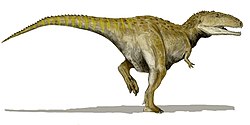Mapusaurus
| Mapusaurus Temporal range: Late Cretaceous
| |
|---|---|

| |
| Mapusaurus roseae | |
| Scientific classification | |
| Kingdom: | |
| Phylum: | |
| Class: | |
| Superorder: | |
| Order: | |
| Suborder: | |
| Family: | |
| Subfamily: | |
| Genus: | Mapusaurus |
| Species | |
| |
Mapusaurus ('earth lizard') was a giant carnosaurian dinosaur from the Late Cretaceous of what is now Argentina. It was similar in size to its close relative Giganotosaurus, with the largest known specimens measuring over 12.2 meters (40 ft) in length and weighing over 3 tons.[1] Mapusaurus was excavated between 1997 and 2001, by the Argentinian-Canadian Dinosaur Project, from an exposure of the Huincul Formation (Rio Limay Group, Cenomanian) at Canadon de Gato. It was described and named by paleontologists Rodolfo Coria and Phil Currie in 2006.[1]
The name Mapusaurus is derived from the Mapuche word Mapu, meaning 'of the Land' or 'of the Earth' and the Greek sauros, meaning 'lizard'. The type species, Mapusaurus roseae, is named for both the rose-colored rocks, in which the fossils were found and for Rose Letwin, who sponsored the expeditions which recovered these fossils.
Classification
Cladistic analysis carried out by Coria and Currie definitively showed that Mapusaurus is nested within the clade Carcharodontosauridae. The authors noted that the structure of the femur suggests a closer relationship with Giganotosaurus than either taxon shares with Carcharodontosaurus. They created a new monophyletic taxon based on this relationship, the subfamily Giganotosaurinae, defined as all carcharodontosaurids closer to Giganotosaurus and Mapusaurus than to Carcharodontosaurus. They tentatively included the genus Tyrannotitan in this new subfamily, pending publication of more detailed descriptions of the known specimens of that form.[1]
Paleobiology

The fossil remains of Mapusaurus were discovered in a bone bed containing at least seven individuals of various growth stages. Coria and Currie speculated that this may represent a long term, possibly coincidental accumulation of carcasses (some sort of predator trap) and may provide clues about Mapusaurus behavior.[1] Other known theropod bone beds include the Allosaurus-dominated Cleveland Lloyd Dinosaur Quarry of Utah, an Albertosaurus bone bed from Alberta and a Daspletosaurus bone bed from Montana.
Paleontologist Rodolfo Coria, of the Museo Carmen Funes, contrary to his published article, repeated in a press-conference earlier suggestions that this congregation of fossil bones may indicate that Mapusaurus hunted in groups and worked together to take down large prey, such as the immense sauropod Argentinosaurus.[2] If so, this would be the first substantive evidence of gregarious behavior by large theropods other than Tyrannosaurus, although whether they might have hunted in organized packs (as wolves do) or simply attacked in a mob, is unknown. The authors interpreted the depositional environment of the Huincul Formation at the Canadon de Gato locality as a freshwater paleochannel deposit, "laid down by an ephemeral or seasonal stream in a region with arid or semi-arid climate".[1] This bone bed is especially interesting, in light of the overall scarcity of fossilized bone within the Huincul Formation.
Technical description and diagnosis
The designated holotype for the genus and type species, Mapusaurus roseae, is an isolated right nasal (MCF-PVPH-108.1, Museo Carmen Funes, Paleontología de Vertebrados, Plaza Huincul, Neuquén). Twelve paratypes have been designated, based on additional isolated skeletal elements. Taken together, the many individual elements recovered from the Mapusaurus bone bed represent most of the skeleton.[1]
Coria and Currie diagnosed Mapusaurus as follows: "Mapusaurus n. gen. is a carcharodontosaurid theropod whose skull differs from Giganotosaurus in having thick, rugose unfused nasals that are narrower anterior to the nasal/maxilla/lacrimal junction; larger extension of the antorbital fossa onto maxilla; smaller maxillary fenestra; wider bar (interfenestral strut) between antorbital and maxillary fenestrae; lower, flatter lacrimal horn; transversely wider prefrontal in relation to lacrimal width; ventrolaterally curving lateral margin of the palpebral; shallow interdental plates; higher position of Meckelian canal; more posteriorly sloping anteroventral margin of dentary. Mapusaurus roseae is unique in that the upper quadratojugal process of jugal splits into two prongs; small anterior mylohyoid foramen positioned above dentary contact with splenial; second and third metacarpals fused; humerus with broad distal end and little separation between condyles; brevis fossa of ilium extends deeply into excavation dorsal to ischial peduncle. It also differs from Giganotosaurus in having conical, slightly curving cervical epipophyses that taper distally; axial posterior zygapohyses joined on midline; smaller and less elaborate prespinal lamina on midline of cervicals; remarkably sharp dorsal margin of cervical neural spines; tall, wider neural spines; curved ischiatic shaft; more slender fibula."[1]
